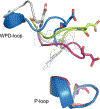Protein tyrosine phosphatases: structure, function, and implication in human disease
- PMID: 23860656
- PMCID: PMC8158066
- DOI: 10.1007/978-1-62703-562-0_13
Protein tyrosine phosphatases: structure, function, and implication in human disease
Abstract
Protein tyrosine phosphorylation is a key regulatory mechanism in eukaryotic cell physiology. Aberrant expression or function of protein tyrosine kinases and protein tyrosine phosphatases can lead to serious human diseases, including cancer, diabetes, as well as cardiovascular, infectious, autoimmune, and neuropsychiatric disorders. Here, we give an overview of the protein tyrosine phosphatase superfamily with its over 100 members in humans. We review their structure, function, and implications in human diseases, and discuss their potential as novel drug targets, as well as current challenges and possible solutions to developing therapeutics based on these enzymes.
Figures













References
-
- Hunter T (2000) Signaling—2000 and beyond. Cell 100:113–127 - PubMed
-
- Pawson T, Scott JD (2005) Protein phosphorylation in signaling—50 years and counting. Trends Biochem Sci 30:286–290 - PubMed
-
- Luan S (2003) Protein phosphatases in plants. Annu Rev Plant Biol 54:63–92 - PubMed
-
- Deutscher J, Saier MHJ (2005) Ser/Thr/Tyr protein phosphorylation in bacteria—for long time neglected, now well established. J Mol Microbiol Biotechnol 9:125–131 - PubMed
-
- Feher Z, Szirak K (1999) Signal transduction in fungi—the role of protein phosphorylation. Acta Microbiol Immunol Hung 46:269–271 - PubMed
Publication types
MeSH terms
Substances
Grants and funding
LinkOut - more resources
Full Text Sources
Other Literature Sources

